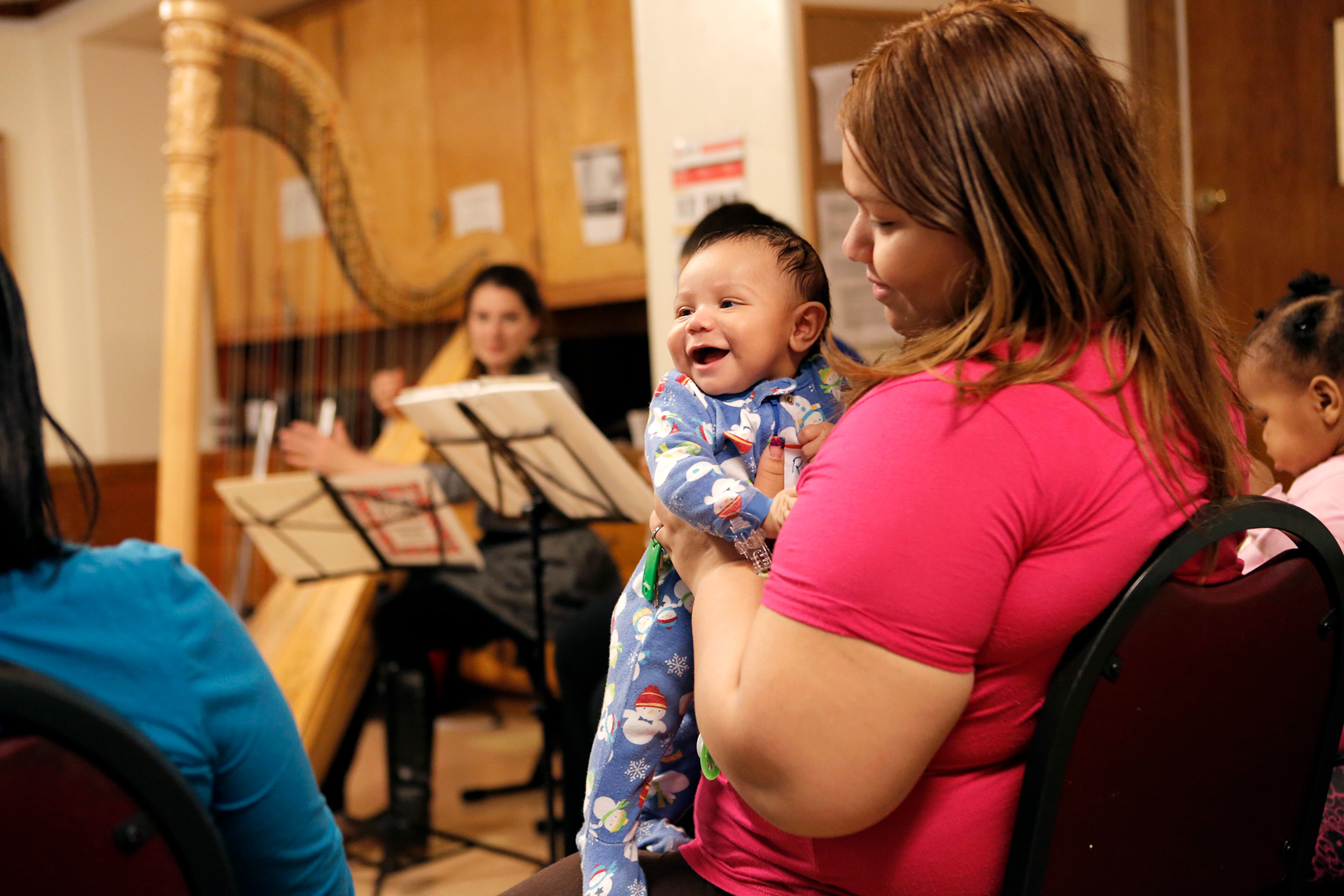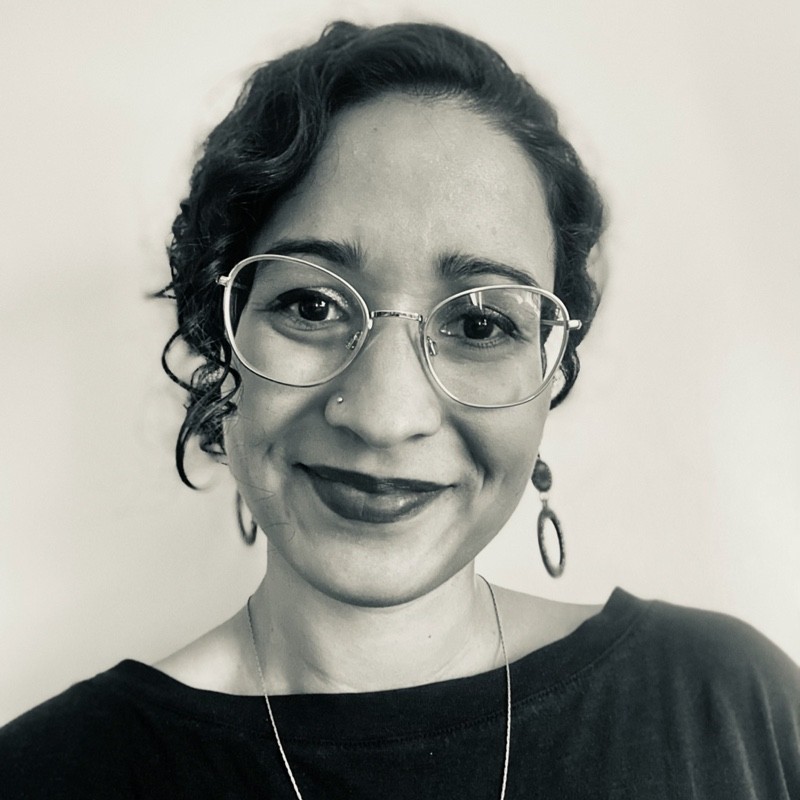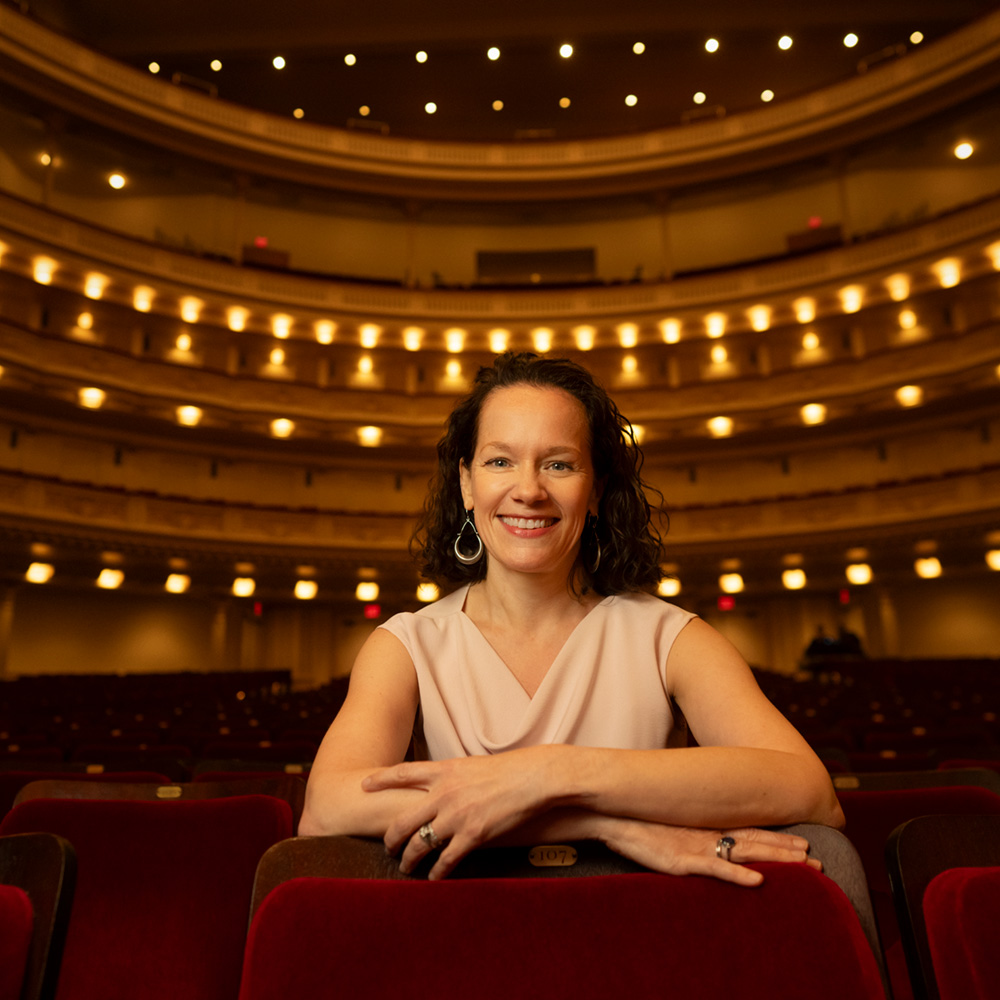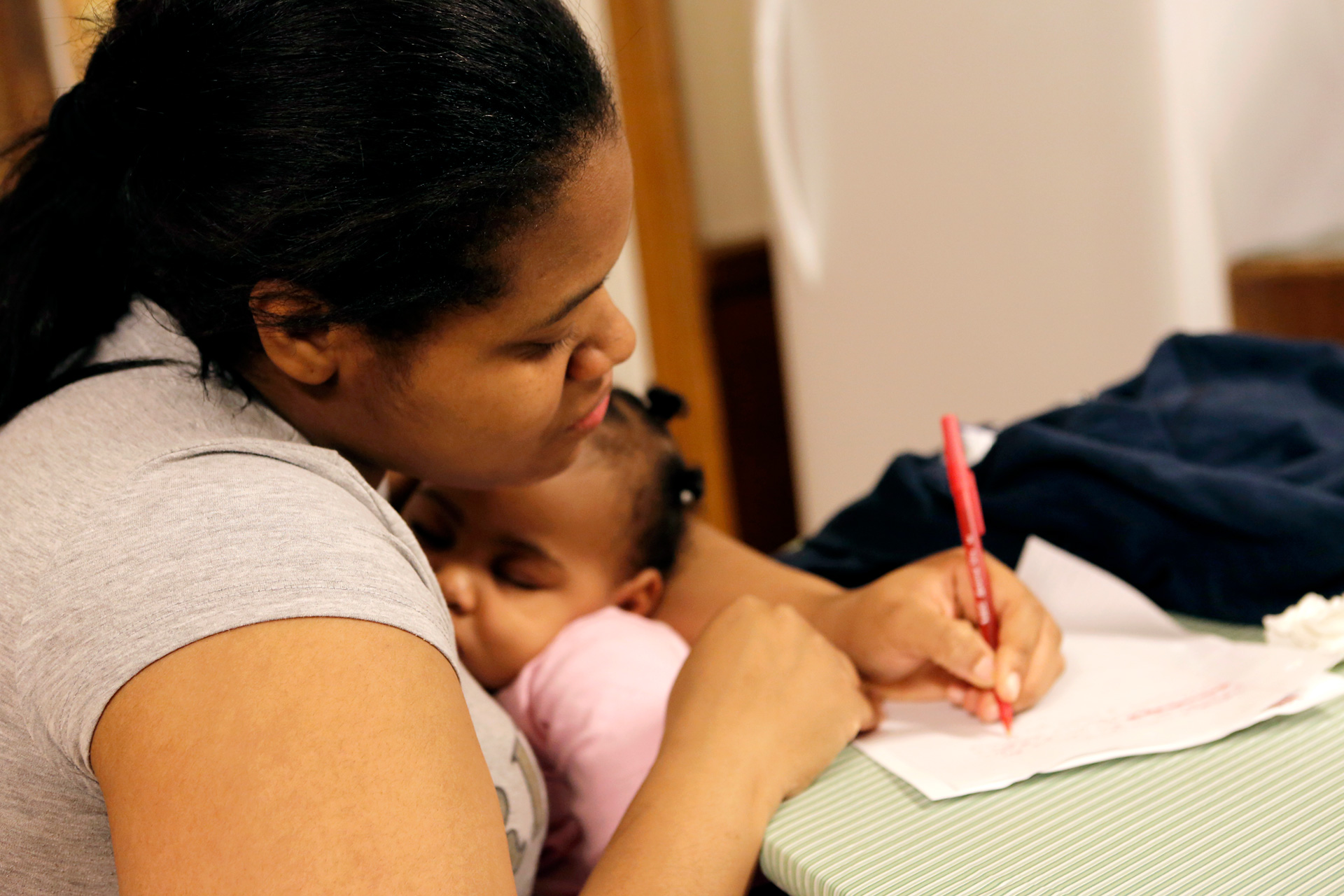From the mountains to the moon,
To the stars and back to you,
We will always walk beside you,
Beside you, beside you.
–Gio and Kaiden, Lullaby Project parents and songwriters

When we hear the word, “lullaby,” most of us imagine something like the dictionary definition of “a gentle, quiet song that lulls a child to sleep,” a cradle song to soothe a baby’s way to the Land of Nod.
For the past 12 years, Carnegie Hall’s Weill Music Institute has been refining that definition with its Lullaby Project, pairing new and expecting parents with professional teaching artists to write lullabies for their babies. Because the parents and caregivers come from a variety of racial, cultural and geographic backgrounds, you’re as likely to hear merengue or the Afrobeat of a djembe as you are to hear a sweet rock-a-bye.
“They’re not all soothing,” says Sarah Johnson, Carnegie Hall’s chief education officer and director of the Weill Music Institute (WMI). “They really become love songs and whatever the parents want them to be. Sometimes a mom will say, ‘My baby is so active, I want to write more of a dance song for her.’ Some of the parents have quite detailed ideas about the music before they even start writing, and others not so much. But it all comes from the parents so the range is huge.”
The Lullaby Project began in Jacobi Medical Center, a New York City public hospital in the Bronx, when a cross-disciplinary team invited WMI to collaborate on a program to support the hospital’s teenage mothers and young parents. Medical staff had observed that the young parents were dealing with high stress levels that sometimes got in the way of their bonding with their infants.
The idea of working with a small group of parents to write personal lullabies for their infants and create a simple recording of the song, evolved into Lullaby’s pilot in 2011. Over the years it has expanded to reach parents in healthcare settings, homeless shelters, high schools and correctional settings. The project, which is now part of WMI’s early childhood and family programs, has nearly 60 organizations worldwide, with well over 4,000 unique lullabies having been written in more than 40 languages—and it’s still growing.
It Starts with a Few Words
The process often starts with the parents being asked to write a letter to their child or to write down their hopes and dreams for themselves as caregivers.
“We ask them where they can imagine their child years from now,” says Tiffany Ortiz, Director of WMI’s early childhood programs. “It serves as a pause button for families to reflect on their parenting experiences and their relationship with their child or child-to-be.

“We have a lullaby journal, which offers a range of prompts. One of the most popular is writing a letter to their baby where parents or caregivers are encouraged to express their hopes and dreams or any stories they want to share with their child. Caregivers are encouraged to think about the language they want to pass down, the cultural rituals within their family they want to pass along or any personal stories about their parenthood experience they want to include.
“We encourage them to think about the melody they want to add to the messages that they wrote, in the right key so they feel comfortable singing this lullaby to their child. We want the song to be something they continue to use, not something that sits on a shelf. We want it to be an active part of families engaging with each other and perhaps passing it down generation to generation, so that it ends up being a beautiful gift to the families.”
My babies, sweet babies,
I love you like crazy.
You’re wonderful and fun,
Sweet like honey buns.
The parents or caregivers are paired with teaching artists and songwriters who work with them to structure lyrics from the key ideas they’ve written, expanding on one another’s ideas and trying out possible melodies and arranging the instrumentation. Accompaniment runs the gamut from piano to marimba, flute to cello, and an array of percussion instruments guaranteed to punctuate and enliven any sentiment. A roster of professional musicians works with the families to create and arrange a song that is uniquely, singularly theirs. The lullaby is recorded for the parent to keep and sing again and again. Each year, some of the new works are selected to be performed at the Hall, some sung by the project’s professional musicians and some by the parents themselves. It’s a delicious process, as plainly seen in this video of the 2023 Lullaby Project’s Celebration Concert.
And the effect apparently lasts. Now that the project is entering its 13th year, WMI has started hosting alumni days to invite lullaby writers to come back to the Hall and share how they’re doing.
“Last year we had a family who came with their 8-year-old who said, ‘We still know our song and we still sing it.’” Ortiz says. “They were so excited to be in the space again and to share and revisit their songs. We’re seeing some long-term ripple effects—seeing so many families come back after many years with their kids grown to share how meaningful the experience has been for them.”
However inspiring, performance is not the project’s primary aim or value. The design was to strengthen the bond between parent and child, aid child development and support parent’s health and well-being, all of which have been accomplished—and then some—according to qualitative analysis by arts research firm WolfBrown, which WMI commissioned to evaluate the project from 2011 to 2017. Researchers found “marked differences” in participants’ positive emotions, engagement, relationships, meaning and sense of achievement, key markers for measuring well-being. Some of the lullaby writers who performed their songs had never spoken—much less sung—in front of an audience.

“You can see people being brave,” Johnson says. “A couple of years ago when one of our writers, Anya, performed, she was shaking when she introduced herself and told her story. You could tell that it was hard for her, but she has this amazing voice, and in that moment, you see her bravery and you see all these other people leaning in and encouraging her. It was quite beautiful.”
👉 Watch Anya’s performance of her lullaby, “Don’t Ever Change,” accompanied by teaching artists James and Camila.
Feeding the Artists
The Lullaby Project has nourished not only the families but the participating musicians and songwriters as well. Johnson says WMI offers the musicians who come into the project professional training and development, along with the resources they need to be successful in their role in supporting the lullaby writers. She also acknowledges that the work isn’t for everyone because not every musician is comfortable with the service aspect of supporting another person’s creativity and process of discovery.
For many though, she says, that has been the most magical part of the process.
“We have many local teaching artists who’ve been part of the project since the inception and continue to come back,” Johnson says. “One said that what feeds them about the project is that they always learn something new about themselves and their community. It isn’t just the parents who are vulnerable. The artists learn from the families in that exchange.
“The artists have created this community of practice where they gather and bring their challenges, they bring something they’re proud of, a song they love that they wrote with someone. Those are durable and generative relationships.”
The process is as much about trust as it is about music, Ortiz says.
“We talk a lot about attunement between parent and child, but there’s quite a bit of attunement that needs to happen among the facilitator, musician and the parent. That requires a level of deep listening, trust-building and a lot of generosity.”

Scaling the Project
Part of the Weill Music Institute’s DNA is to broadly share what they’ve developed, Johnson says. They have designed the Lullaby Project to be nimble, portable and scalable. Although they believe in the superpower of artists, she says, they have looked beyond the professional teaching artists they work with to see who else in a community might be able to bring the project to families most in need. For example, they’re exploring a project with a partner in India that would provide a simple set of video resources that would enable health workers to support lullaby writing in their communities. Their lead partner in Australia is experimenting with creating a library of lullaby music templates to which personalized lyrics could be added, expanding the capacity of lullaby writing without benefit of facilitators.
“The growth has been organic,” Johnson says. “When we moved from Jacobi Medical Center, it was because people wanted to take it other places and were knocking on our door asking if they could take it to a refugee camp in Athens or to this or that place. We have access to extraordinary resources—the Carnegie Hall name, our artistic relationships, our human capital and our partnerships—that enable us to develop things that are often useful in other places. And then give them away.
“We dream about a world in which every parent might be able to write a personal lullaby for their child,” she says. “A colleague of ours often says that when a child is born, so too is a parent and when we think about these personal lullabies, they are just as much for the parent as they are for the child. These lullabies are little vessels of love, and who wouldn’t want more of that in the world.”
Taking Your Toddler to Carnegie Hall
If music be the food of love, then Carnegie Hall’s Weill Music Institute (WMI) offers a banquet the whole family can feast on. WMI encompasses the Hall’s education and social impact programs, whose mission is to make great music accessible to the widest possible audience. Hundreds of families in New York City and throughout the world have found their way to music through Carnegie Hall’s array of age-appropriate offerings, from live performances to free online resources to spark the curiosity and enthusiasm that can last a lifetime. More than 800,000 people each year engage in WMI’s programs through national and international partnerships, in New York City schools and community settings, and at Carnegie Hall.
The early childhood programs of Weill Music Institute are designed specifically with babies and toddlers in mind—colorful, lively and sometimes silly—creating musical experiences that feed the developing brain and imagination. Since its inception 12 years ago, the Lullaby Project has been at the heart of the WMI’s early childhood programs, a rich ecosystem that brings music to life in a child’s earliest years.
Save the Dates for Ways to Tune In
- Camille’s Rainbow, April 2-6: Immersive concert for babies and toddlers being performed twice daily in the Hall’s Resnick Education Wing. Check here for more information. For families who are unable to attend the in-person event, WMI is providing six brief, animated videos featuring original music from the live show.
- Big Note, Little Note: a 10-week music class for New York City families that offers parents and caregivers a range of experiences to engage with their babies, ages 3 months to 18 months, through singing, musical play and more. Classes are offered in person and online in partnership with local community organizations. A selection of short videos and an accompanying “Music Moments” activities series is available for parents everywhere on the Big Note, Little Note website, each dedicated to a specific early childhood topic such as movement, brain building and more. A playlist with original songs inspired by the themes of the class is available on SoundCloud.
- Family Day: Spring Fest, Noon-4 pm April 20: Children ages 3 –10 and their caregivers are invited to the Hall’s Resnick Education Wing for a free open house offering interactive, playful activities that celebrate the earth, nature and all things spring. Highlights of Family Day include instrument building, group singing, a soothing sound meditation, hands-on playing with instruments, lively mainstage performances, and much more. The Nest, an interactive performance created by Connecting the Dots in Australia, will also be presented.
- Celebration Concert of Live Performance of Lullabies, 3pm, June 1, Carnegie Hall. Select lullabies are performed live each year as part of the Lullaby Project’s Celebration Concert at 3 pm on Saturday, June 1 at Carnegie Hall’s Zankel Hall. Tickets are $23: carnegiehall.org, 212-247-7800.
Resources
- To better understand the effect of music in early childhood development, Carnegie Hall commissioned papers from arts research expert Dr. Dennie Palmer Wolf. The first, Why Making Music Matters: Singing, Playing, Moving, and Sharing in the Early Years, points to key reasons why investing in children early and often is critical to healthy development and a successful future—and demonstrates the role music can play in everyday interactions that support children.
- Lullaby: Being Together, Being Well, looks at how and why lullabies make a difference, highlighting how the Lullaby Project helps families come together and imagine a positive future for children, and how writing a lullaby often can support a deeper process of connecting and communicating among parents, grandparents, musicians, staff and community members.
- Inspired by the Lullaby Project, the Bernard van Leer Foundation commissioned WolfBrown to write a paper, Making a Joyful Noise: The Potential Role of Music Making in the Well-Being of Young Families, which explores the Lullaby Project alongside early childhood programming from around the world.
- Unwind with Lullabies: Hopes & Dreams In April 2018, Decca Gold (Universal Music Group) released an album of 15 original lullabies written by Lullaby Project participants and performed by world renowned artists including Fiona Apple, the Brentano String Quartet, Lawrence Brownlee, Rosanne Cash, Joyce DiDonato, Angélique Kidjo, Natalie Merchant, Dianne Reeves, Gilberto Santa Rosa and others. The album is available from the Carnegie Hall Shop and other online retailers.

K.C. Compton
K.C. Compton worked as a reporter, editor and columnist for newspapers throughout the Rocky Mountain region for 20 years before moving to the Kansas City area as an editor for Mother Earth News. She has been in Seattle since 2016, enjoying life as a freelance and contract writer and editor.


